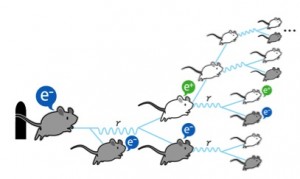Antimatter is like the shadow of matter, sharing same features, such as mass or spin. The electric charge, however, is opposite. The electron’s antimatter partner is called the positron and carries a positive charge. Antimatter rarely exists in our everyday world. However, for a linear collider, a myriad of positrons will be necessary to collide with electrons. So scientists need to produce them.
Positrons are created through a reaction called electron-positron pair production. First, a high-energy electron beam is directed to a metal target, which is generally made of tungsten. When electrons pass through the target, they interact with the positively charged nuclei of atoms within the target and emit gamma rays. Gamma rays quickly convert into electron-positron pairs, thus creating electrons and positrons which then again radiate gamma rays. These reactions, in which electrons and positrons multiply like rats, are called electromagnetic showers. With this technique, many electrons and positrons are produced from one high-energy electron source.
As electrons and positrons are created in pairs, it is then necessary to separate and collect only positrons. Emitted particles are first placed into a high magnetic field produced by a solenoid coil. This field is roughly parallel to the particle tracks, so that electrons and positrons are directed in the forward direction. In the next step, positrons enter acceleration tubes and only those which have the required energy are accelerated by the strong electromagnetic wave. Usually, only accelerated positrons within a relatively narrow band of energy are used for experiments. After the acceleration of some amount, electrons are thrown away by a bending magnet.
“The positron source being considered for the International Linear Collider is more complex,” KEK physicist Tsunehiko Omori says. The baseline design for the ILC uses a helical undulator, a device to produce polarised photons. And then, polarised positrons are created from polarised photons.If polarised positrons are used in an experiment, they present clear results because they have oriented spin. “A beam of polarized positrons would allow us to categorise their reactions with electron easier, and increase precision in many important measurements”, said Omori. “For the ILC, positrons will be produced from the electron beam, which is also used for the collisions. This causes the complexity of the ILC positron source. The positron source is one of the biggest pieces of homework in our post-Technical Design phase,” Omori says.


Recent Comments